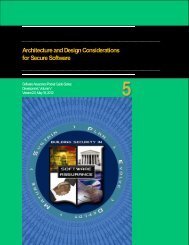Secure Coding SwA Pocket Guide - Build Security In - US-CERT
Secure Coding SwA Pocket Guide - Build Security In - US-CERT
Secure Coding SwA Pocket Guide - Build Security In - US-CERT
You also want an ePaper? Increase the reach of your titles
YUMPU automatically turns print PDFs into web optimized ePapers that Google loves.
environments where performance and a small footprint are important (such as embedded devices and smart cards). A JavaVirtual Machine (JVM) may introduce too much strain on the system, resulting in potential denials of service. It is security issuessuch as these that make it important to have an understanding of which weaknesses exist or are more likely to appear based onthe choice of language.“Safe” languages: Most “safe” languages (or language variants) are intended to help avoid problems with buffers, pointers, andmemory management. The bounds-checking interfaces developed by Microsoft and included in the emerging C1X standard canmitigate vulnerabilities resulting from improper string management in existing C programs. If the program is expected to operatein a particularly exposed environment, on cell phones, or on the web, use a language that includes its own security model andself-protecting features (e.g., Java, Scheme, Categorical Abstract Machine Language). Alternatively, implement a virtual machineon the host system to contain and isolate the program.Advantages of static typing: Languages with static typing such as Java, Scheme, MetaLanguage (ML), F#, and Ada ensurethat operations are only applied to values of the appropriate type. Type systems that support type abstraction let programmersspecify new, abstract types and signatures for operations. Such typing prevents unauthorized code from applying operationsinappropriate for the given values. <strong>In</strong> this respect, type systems, like software-based reference monitors, go beyond operatingsystems in that they can be used to enforce a wider class of system-specific access policies. Static type systems also enableoffline enforcement through static type checking rather than checking based on each specific instance of operation. This allowsthe type checker to enforce rules that are difficult to enforce with online techniques.Built-in security mechanisms: Newer languages, such as C# have a variety of security mechanisms built into the languageincluding type safe elements, code access security, and role-based security included via the .NET framework. Although the .NETframework and C# contain many elements that can assist in secure development, it is still incumbent on the development team toproperly use these elements. It is important to note that there may be certain features of the language that will provide moresecurity; however, other aspects may open new security vulnerabilities. Therefore, it is necessary to stay informed on anyvulnerabilities or issues that may arise from using the selected language.Some languages can reduce the damage that un-trusted programs can do by limiting the system calls that the program caninvoke. Perl does this through its “taint mode,” which only allows user-supplied input that is explicitly specified as “untainted” bythe programmer [Birznieks 1998]. Java provides the JVM as a “sandbox” and does not allow an un-trusted program to act outsidethe JVM. For example, un-trusted Java applets cannot create a new process or read/write to the local disk [Venners].Don’t rely on language choice alone: While picking a secure programming language is important, many developers make themistake of assuming that a secure language is a panacea for security vulnerabilities. Regardless of the language used,developers with little to no knowledge of secure coding will deliver insecure code; therefore, there needs to be a securedevelopment process [Rook 2010].Resources» CGI/Perl Taint Mode FAQ. Birznieks, Gunther, 3 June, 1998. 20 July 2010.» “Your choice of programming language doesn’t matter, they are all insecure!” Rook, David. <strong>Security</strong>Ninja: <strong>Security</strong> Research, News & Guidance. Realex Payments. 15 October 2010..» United States Government. Department of Homeland <strong>Security</strong> - Software Assurance Forum Processand Practices Working Group. “Enhancing the Development Life Cycle to Produce <strong>Secure</strong> Software.”The Data & Analysis Center for Software [DACS]. October 2008 Version 2.0. United StatesGovernment. Defense Technical <strong>In</strong>formation Center. 24 June 2010.» “Java's security architecture.” Venners, Bill. JAVAWORLD. 1 August 1997. 20 July 2010.Software Assurance <strong>Pocket</strong> <strong>Guide</strong> Series:Development Volume VI – Version 2.0, , May 18, 2012<strong>Secure</strong> <strong>Coding</strong>5
















